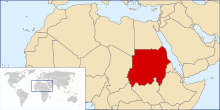
Back تاريخ السودان Arabic Historia de Sudán AST История на Судан Bulgarian Història del Sudan Catalan Dějiny Súdánu Czech Geschichte des Sudan German Wëlthɛɛr ë Thudän DIN Historia de Sudán Spanish Sudango historia Basque Sudanin historia Finnish

| History of Sudan | ||||||||||||||||||
|---|---|---|---|---|---|---|---|---|---|---|---|---|---|---|---|---|---|---|
 | ||||||||||||||||||
| Before 1956 | ||||||||||||||||||
|
||||||||||||||||||
| Since 1955 | ||||||||||||||||||
|
||||||||||||||||||
| By region | ||||||||||||||||||
| By topic | ||||||||||||||||||
| Timeline | ||||||||||||||||||
The history of Sudan refers to the territory that today makes up Republic of the Sudan and the state of South Sudan, which became independent in 2011. The territory of Sudan is geographically part of a larger African region, also known by the term "Sudan". The term is derived from Arabic: بلاد السودان bilād as-sūdān, or "land of the black people",[1][2] and has sometimes been used more widely referring to the Sahel belt of West and Central Africa.
The modern Republic of the Sudan was formed in 1956 and inherited its boundaries from Anglo-Egyptian Sudan, established in 1899. For times predating 1899, usage of the term "Sudan" mainly applied to the Turkish Sudan and the Mahdist State, and a wider and changing territory between Egypt in the North and regions in the South adjacent to modern Uganda, Kenya and Ethiopia.
The early history of the Kingdom of Kush, located along the Nile region in northern Sudan, is intertwined with the history of ancient Egypt, with which it was politically allied over several regnal eras. By virtue of its proximity to Egypt, Sudan participated in the wider history of the Near East, with the important 25th dynasty of Egypt and the Christianization of the three Nubian kingdoms Nobatia, Makuria, and Alodia in the sixth century. As a result of Christianization, the Old Nubian language stands as the oldest recorded Nilo-Saharan language (earliest records dating to the eighth century in an adaptation of the Coptic alphabet).
While Islam was already present on the Sudanese Red Sea coast and the adjacent territories since the 7th century, the Nile Valley did not undergo Islamization until the 14th-15th century, following the decline of the Christian kingdoms. These kingdoms were succeeded by the Sultanate of Sennar in the early 16th century, which controlled large parts of the Nile Valley and the Eastern Desert, while the kingdoms of Darfur controlled the western part of Sudan. Two small kingdoms arose in the southern regions, the Shilluk Kingdom of 1490, and Taqali of 1750, near modern-day South Sudan, but both northern and southern regions were seized by Muhammad Ali of Egypt during the 1820s. The oppressive rule of Muhammad Ali and his immediate successors is credited for stirring up resentment against the Turco-Egyptian and British rulers and led to the establishment of the Mahdist State, founded by Muhammad Ahmad in 1881.
Since independence in 1956, the history of Sudan has been tarnished by internal conflict, including the First Sudanese Civil War (1955–1972), the Second Sudanese Civil War (1983–2005), the War in Darfur (2003–2020)–culminating in the secession of South Sudan on 9 July 2011, after which the South Sudanese Civil War took place therein (2013–2020)– and the current War in Sudan (2023–present).
- ^ Encyclopædia Britannica. "Sudan" Archived 2013-10-29 at the Wayback Machine.
- ^ Department of Arts of Africa, Oceania, and the Americas. Trade and the Spread of Islam in Africa Archived 2013-05-17 at the Wayback Machine. In Heilbrunn Timeline of Art History. New York: The Metropolitan Museum of Art, 2000 – (October 2001).
© MMXXIII Rich X Search. We shall prevail. All rights reserved. Rich X Search